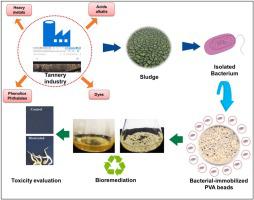Journal of Water Process Engineering ( IF 6.3 ) Pub Date : 2021-04-08 , DOI: 10.1016/j.jwpe.2021.102059 Pooja Yadav , Ashutosh Yadav , Janmejai Kumar Srivastava , Abhay Raj

|
The purpose of this present study was to reduce the pollution load of the tannery effluent through a cell immobilization approach using chromium tolerant bacteria isolated from tannery sludge. Among various initially isolated bacteria, strain IITR002 exhibited the highest pollution load reduction was characterized as Ochrobactrum intermedium by 16S rDNA sequencing. The bacterium was successfully immobilized with 10 % polyvinyl alcohol (PVA) and 1% sodium alginate (SA) and tannery effluent treatment were carried out using both free and immobilized cells of O. intermedium. Preliminary chemical oxygen demand (COD) reduction studies demonstrated 85 % and 54 % COD reductions by immobilized and free cells, respectively as compared to blank PVA beads (10 % COD). Both free and immobilized cells were able to degrade tannery effluent after 48 h but the reduction of total dissolved solids-TDS (56 %), COD (85 %), biochemical oxygen demand-BOD (68 %), and total chromium-TC (95 %) were higher with immobilized cells. The reduction of pollutants in tannery effluent was established by GC–MS analysis in which degradation of organic pollutants after treating with free and immobilized cells was observed. Phytotoxicity investigation of tannery effluents on Vigna radiata L seed showed that bacterial treatment not only allowed seeds germination but also supported seedling growth. The results from this flask-scale work suggest that immobilized cell methods of bacterial treatment can potentially be applied in tannery effluent treatment to reduce the pollution load as well as phytotoxic effects.
中文翻译:

利用中间O骨细胞固定化方法降低制革厂废水的污染负荷
本研究的目的是通过使用从制革厂污泥中分离出来的耐铬细菌的细胞固定方法来降低制革厂废水的污染负荷。在各种最初分离的细菌中,通过16S rDNA测序,菌株IITR002表现出最高的污染负荷降低特征,被定为中间O牙O。用10%的聚乙烯醇(PVA)和1%的海藻酸钠(SA)成功固定了细菌,并使用游离和固定的O. intermedium细胞对制革厂废水进行了处理。。初步化学需氧量(COD)减少研究表明,与空白PVA珠粒(10%COD)相比,固定细胞和游离细胞分别减少了85%和54%的COD。游离和固定化细胞均可在48小时后降解制革厂废水,但总溶解固体-TDS(56%),COD(85%),生化需氧量-BOD(68%)和总铬-TC( 95%)的固定细胞更高。制革厂废水中污染物的减少是通过GC-MS分析确定的,其中观察到了用游离的固定化细胞处理后有机污染物的降解。制革废水对Vigna radiata的植物毒性研究L种子表明,细菌处理不仅使种子发芽,而且还支持幼苗生长。烧瓶规模工作的结果表明,固定化细菌处理细胞方法可潜在地用于制革厂废水处理,以减少污染负荷和植物毒性作用。











































 京公网安备 11010802027423号
京公网安备 11010802027423号